An artist of remarkably diverse talents in a career spanning 47 years, Robert Huff never lost touch with his love for drawing and experimenting with the tools of his family's construction business. To that passion for the pure craft of making and building objects large and small, he brought a deep sensitivity to the fragile beauty of natural resources surrounding places where he lived and worked, primarily South Florida and the Appalachian mountains of Virginia.
His untimely death in Miami at age 69 on August 22, 2014, was widely mourned in South Florida. "Robert Huff: 47 Years," organized by the Miami Dade College Museum of Art + Design, is an overdue look at the artist’s career. From 1969 to 2013, his art was included in more than 20 solo exhibits in Florida and elsewhere. Additionally, his work was selected for dozens of group exhibits at Florida museums and galleries, as well as in Chicago, United Arab Emirates, and Kassel, Germany.
He traveled for an artist's residency to the former USSR in 1989 and 1990 as a guest of Michigan's Lakeside Studios and the Soviet Artists Union. He was also prolific in the field of public art, with numerous public art commissions throughout Florida.
.

Robert Huff in the studio, 1986. Photo credit: Richard Lee Williams.
.
Legacy as Artist and Educator
Huff is remembered not only as a multi-talented artist but as a profoundly influential art educator in South Florida, sharing his deep knowledge with colleagues, other artists, and countless students.
Born in Kalamazoo, Michigan, he moved to Florida's west coast at the age of 11. The state would forever play a major role in his professional life. Soon after earning an MFA from the University of South Florida in 1968, he began teaching at what was then called Miami-Dade Community College, South Campus. From 1979 until his retirement in 2005, he chaired the visual arts department at that same institution, now known Miami Dade College, Kendall Campus.
It's fitting that Miami Dade College's young museum, founded in 2012 as MDC Museum of Art + Design, should present this retrospective. "Huff was instrumental in laying the groundwork for the institution honoring him today," wrote MDC Museum Director Jeremy Mikolajczak in his introduction to the catalog for this exhibit. Without Huff's contributions, the "museum would not have the important works within the collection acquired during his tenure."
The artist's legacy as an educator is integral to his artistic legacy, as indicated by the March 2013 oral history interview with him conducted by art historian Helen Kohen. Explaining his role in helping MDC start its art collection, he explained, "The impetus behind that whole thing was the fact that we were teaching humanities classes and art appreciation classes to non-majors using slides, and it was ludicrous because they had no idea of scale. They had no idea of intimacy, nothing to do with the actual work … So that was how we sold it as art, and actually, the funding probably came from a humanities grant."
.
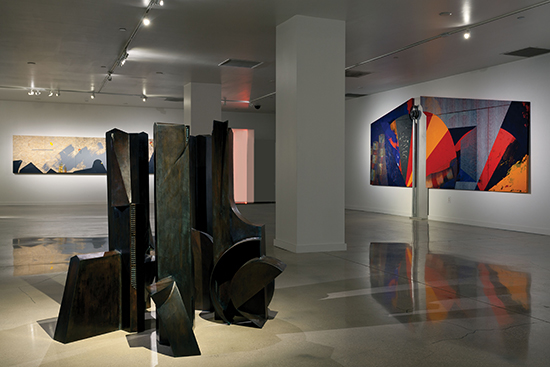
LEFT (Background); Robert Huff “Clinch River”, 2012, pencil, acrylic, OSB, 42 x 160 1/2 x 4 inches. CENTER (Foreground): Robert Huff, “Sidh Structures”, 1999, bronze (5-Pieces), 52 x 48 x 66 inches. RIGHT (Background): Robert Huff, “Pete’s Pulley”, 1996, acrylic, pencil, aluminum, canvas, 8’9" x 16’6” x 6 1/4." Courtesy of MOA+D. Photo: Francesco Casale.
.
Expansive Creative Vision
With 34 works from the early 1970s to 2014, "Robert Huff: 49 Years" underscores the artist’s impressive versatility in many media, from drawing to painting to printmaking to sculpture. The exhibition illustrates how he adapted particular imagery and themes, giving individual works a heightened significance, making it clear that they are part of an expansive creative vision undergirding a steadily productive career, as both artist and educator.
.
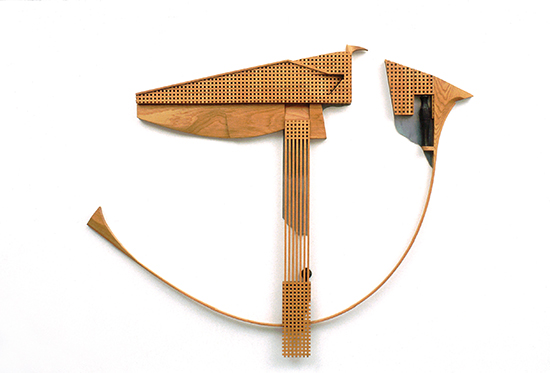
"Rigger V" by Robert Huff, 1988. Wood, aluminum, found parts, 64 x 76 x
3 inches. Photo: Robert Huff.
.
While some early works, such as the 1971 silkscreen on paper Rainbow City, display a casual, trippy playfulness, it's thrilling to see Huff shaping and amplifying his artistic voice with solid and engaging works throughout his career.
Lush, Plush Surroundings
Early on, his questing artist's eye looked for ways to mine the intersecting visual relationships he found in built and natural environments, particularly in South Florida. Reflecting on his career in that March 2014 oral history interview, he characterized those surroundings "as pretty lush. I mean plush."
Writing about how the South Florida environment had shaped his work, in the 2007 book “Miami Contemporary Artists” by Paul Clemence and Julie Davidow, Huff praised the region's intense sunlight, adding that "I have always considered myself a landscape artist … My work not only concentrated on the light and natural landscape but also became involved in the architectural impositions on that landscape."
Lush, indeed plush, color in the form of azure-to-indigo blues glimmering in the sun-splashed waters and skies of South Florida shape a seductive context to such works as Miami Windows/Miami, created with pencil and acrylic on canvas. The work is animated by restless tensions: bold, geometric forms intersect with fragmented references to a place marked by blood-red dawns and emerald-green mangrove clusters edging Biscayne Bay's ever-evolving coastline.
.
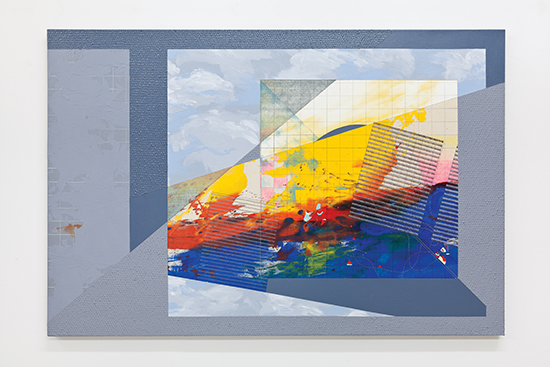
"Miami Windows, Miami" by Robert Huff, 1982. Pencil, acrylic on canvas, 48 x 72 inches. Photo: Francesco Casale/Letter16 Press.
.
With its shaped and irregularly constructed canvas echoing doorways and buildings, the imposing Smolny Sonata of 1990 is a splendid composition weaving together Huff's three-dimensional formal concerns with his love for brilliant color. It's named for Smolny, a central area in St. Petersburg, Russia, famed for its historic architecture from the 18th and 19th centuries, and was surely inspired by his artist residency in the former USSR.
.
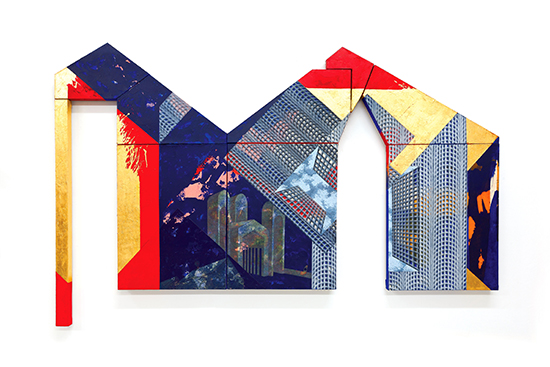
"Smolny Sonata" by Robert Huff, 1990. pencil, acrylic, oil, gold leaf on canvas, 68 1/2 x 88 x 1 1/2 inches. Photo courtesy of MOA+D. Photo: Francesco Casale.
.
Again, Smolny Sonata displays Huff's signature, precisely shaded architectural grids, displaying fastidious line-drawings created with his ever-present artist's tool, the pencil. Sometimes grids are tilted to lead the eye further into receding space, where passages of fluffy clouds tease viewers like sudden daydreams. The grids also open to a world of shadowy urban avenues, rendered with Huff's architectural precision, suggesting further forays into still-to-be explored urban neighborhoods. Framing this composition are searing abstract passages of red and gold-leaf, evoking the majestic palette of Russian icons, revealing how Huff's porous imagination was remarkably attuned to what was visually distinctive in his immediate surroundings.
Shimmering echoes of South Florida water and light infiltrate the 1996 Pete's Pulley, created with acrylic, pencil, wood, aluminum and canvas. An aluminum panel slices the shaped canvas in two, extending beyond the canvas to the floor. Ultimately this is an abstract composition, but it reveals Huff's gift for portraying allusions to the natural environment in counterpoint with the built environment. There's an implication that ongoing construction and urban growth undermine fragile natural resources of water and light. Shadowy cylindrical shapes, perhaps evoking towers of Turkey Point nuclear power plant visible from Miami's Biscayne Bay, form an ominous contrast to the work's bold abstract passages of subtropical orange and yellow.
Bearing Witness to Appalachia
In the rhythmic and intricately composed abstract bronze sculpture Sidh Structures of 1999, it's possible to see within the work’s formal strengths occasional reminders of mountainous countryside.
After Huff retired from teaching, he spent more and more time at the rural retreat and studio he and his wife Barbara Young retrofitted from a former Boy Scout camp in Virginia's Appalachian mountains.
This led to his body of work informed by time in Appalachia. Huff observed how the coal mining industry, with the advent of strip mining and fracking, is dramatically altering a lush, mountainous setting. The insidious aftermath of mountaintop removal scars a centuries-old wilderness with relentless efficiency.
His later paintings and drawings bear subtle witness to a besieged Appalachia, again illustrating his visual talents for metaphor by creating works melding forms of abstraction and landscape. In Clinch River, a row of black, chipped triangular forms surely evoke distressed mountains. Clusters of conical shapes recall cooling towers of power plants. Pale, lightly textured abstract passages slathered with gray can bring to mind grim remnants of a denuded landscape.
The sober palette of these final works contrasts mightily with the visual generosity of previous pieces suffused with South Florida light. Still, works from this "Appalachian period" are all of a piece with previous art, for Huff makes clear his consistent preoccupation with the endangered, natural world he loved so much.
.
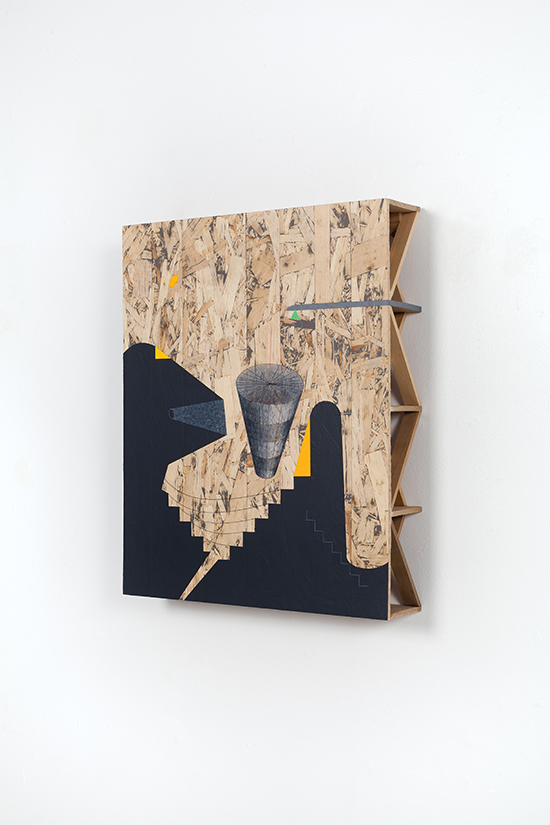
"HR 6-12" by Robert Huff, 2012. Pencil, acrylic, OSB, 20 x 16 x 4 inches. Photo: Francesco Casale/Letter16 Press.
.
________________________________
BASIC FACTS: "Robert Huff: 47 Years" continues through November 8, 2015 at MDC Museum of Art + Design, The Freedom Tower at MDC, Second Floor, 600 Biscayne Blvd, Miami FL 33132. Telephone 305-237-7700; www.mdcmoad.org
________________________________
Copyright 2015 Hamptons Art Hub LLC. All rights reserved.

Let’s not forget: Robert Huff: 47 Years is accompanied by a fully illustrated 80-page catalogue with essays by curator, Carol Jazzar and Beth Dunlop, author and editor in chief of MODERN magazine, with an introduction by Executive Director, Jeremy Mikolajczak. And grateful to share my drawings are in the current exhibit ‘Into the Wild’ curated by Carol Jazzar at Miami-Dade Kendall Gallery. Curator and artist mingling Oct 3rd, 1-3PM. http://www.mdc.edu/publications/MGAD_3059_IntotheWild
Thank you for that Eliisa.
Great write up about the artist Robert Huff and this new exhibition. Thanks Elisa Turner! I met him in 2005 when he hired to teach PT at the Kendall Campus. Gone too soon.